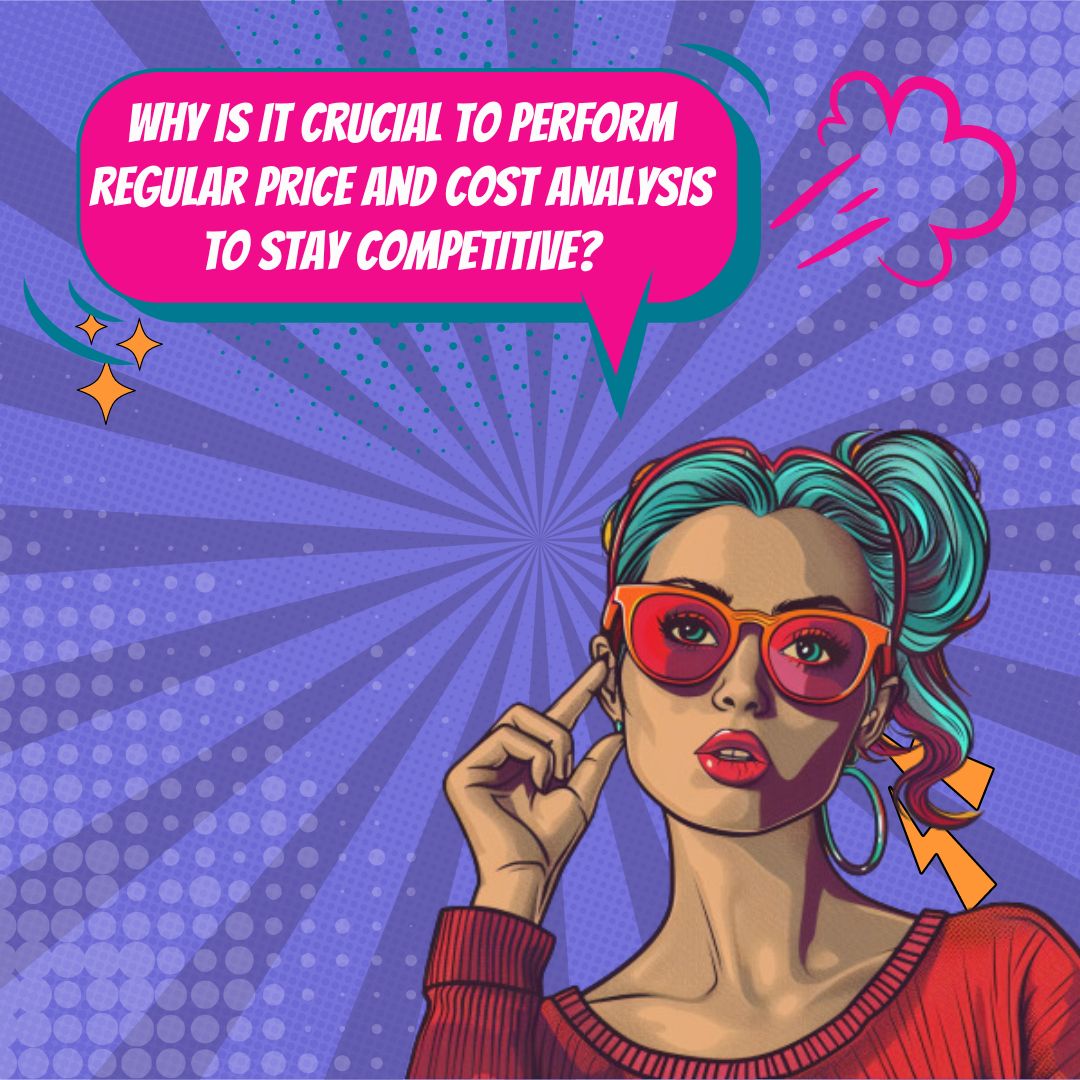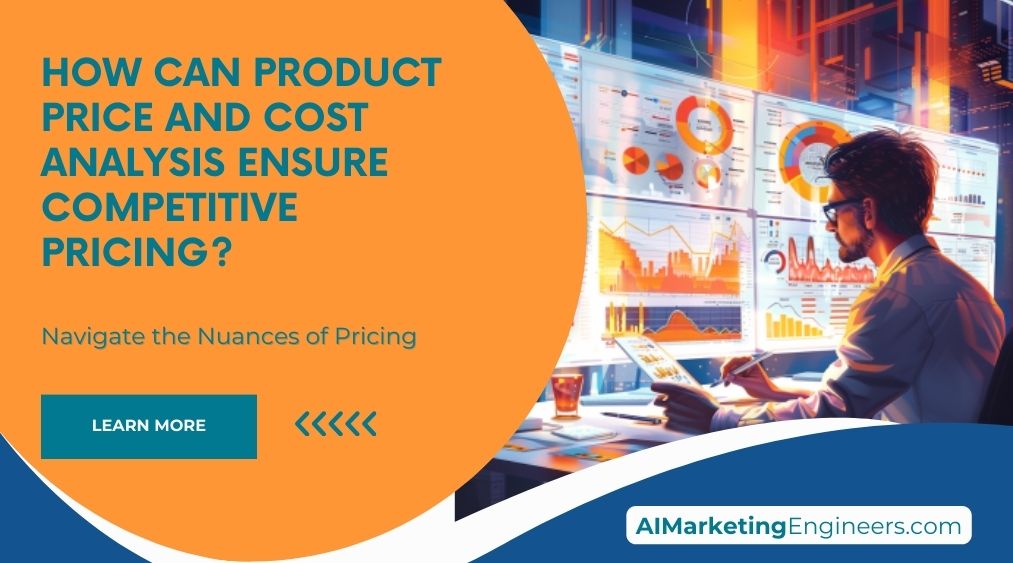Key Takeaways
✅ Competitive Pricing is not just about setting lower prices than others. A thorough product price and cost analysis gives businesses deep insights into how much it really costs to bring their offerings to market. On average, a 1% improvement in price, assuming no loss of volume, can lead to an 11% increase in profit, according to a study by McKinsey & Company. It’s with these figures in mind that businesses must employ diligent analysis.
✅ Cost Analysis is the backbone of a fair and competitive pricing strategy. A detailed breakdown highlights potential savings and inefficiencies, which could pave the way for smarter financial decisions. For instance, a minor 2-5% reduction in cost of goods sold (COGS) can translate into a substantial boost in profit margin, particularly for industries operating on thin margins.
✅ Did you know that close to 60% of businesses don't regularly review their prices? Yet, continuous Price Analysis is critical in capturing what customers are willing to pay. Regular adjustments based on market needs and competitor prices ensure businesses stay relevant and profitable. Therefore, avoiding regular price review is essentially leaving money on the table.

Introduction
Why does the price tag on a product have the power to make or break a business? The art of setting the right price is like walking a tightrope – it demands a perfect balance between attracting buyers and ensuring a decent profit. That's where a solid understanding of product price and cost analysis plays a crucial role in the theater of business.
Imagine being able to pinpoint the perfect price for your product – one that customers are happy to pay, yet still allows you to keep the lights on and even expand. Sounds like a dream, right? But it isn’t; with the right techniques and knowledge, it’s very much within reach.
Within these lines, you'll find not just theories but practical, actionable insights that can reshape your approach to pricing. By the end of this piece, you'll be equipped with the tools needed to craft a pricing strategy that not only covers costs but also capitalizes on your market position, ensuring you stay one step ahead in the competitive game. Ready to charge into the world of savvy pricing? Let's dive in!

Top Statistics
| Statistic | Insight |
|---|---|
| Dynamic Pricing Impact: Revenue increase of up to 10% and profitability by up to 25%. (Source: McKinsey & Company) | Adopting dynamic pricing strategies can significantly boost both your top-line and bottom-line, making it a crucial aspect of competitive pricing. |
| Personalized Products: 42% of consumers ready to pay more. (Source: Deloitte) | Pricing isn’t just about cost, but value. Consumers show they’re willing to spend more if the product meets their personal needs and preferences. |
| Market Growth: Price optimization software market expected to reach $3.7 billion by 2025. (Source: MarketsandMarkets) | The surge in market size for price optimization tools suggests a growing recognition of the need for sophisticated pricing solutions in staying competitive. |
| Profitability and Cost Analysis: 30% higher profitability for companies conducting thorough analysis. (Source: Harvard Business Review) | The link between in-depth cost analysis and increased profitability underscores its critical role in making data-driven pricing decisions. |
The Importance of Competitive Pricing
When launching a product, setting the right price is a dance between being attractive to consumers and ensuring you're not leaving money on the table. Competitive pricing is key to this balance, affecting everything from customer purchase decisions to market share and profitability. But here's the million-dollar question: How can product price and cost analysis keep your offerings competitively pitched? It's about much more than just undercutting competitors; it's understanding market positioning, customer value perception, and internal cost structures to come up with that sweet spot price.

Understanding Cost Components
Every product comes with its unique concoction of costs. Raw materials, labor, and overheads—they all add up to form the base price you can't go below without compromising your business. But what exactly are these costs doing to your price? For instance, if the cost of raw materials spikes, how will this affect your retail price and profit margin? Getting a grip on the precise impact of each cost component on the final price helps businesses avoid the pitfalls of undercharging or overcharging customers.
Conducting a Cost Analysis
So, you're ready to dive into a cost analysis. The path to insight starts with listing every cost, big or small, that feeds into producing your product. From here, calculate your cost per unit, scrutinizing which areas might offer leeway for reductions. Could cheaper materials work just as well? Is there a way to streamline labor costs? Identifying the main cost drivers gives you a map of where savings might be found, helping keep prices competitive without compromising quality.
Assessing Competitor Pricing
Gather competitor pricing data—it's essential. Whether it's through detailed market research, exploring online platforms or utilizing comparison tools, understanding where your competitors stand price-wise is vital for positioning. What strategies are they using? Are they pushing the premium angle or racing to the bottom? This analysis crucially informs whether your product's pricing strategy draws customers in or pushes them towards another option.

Determining the Ideal Price Point
Setting the right price is an intricate process. Think about how customers see your product. Is it a luxury item or a budget-friendly choice? How do your profit margin requirements shape your pricing? If competitors slash their prices, should you follow suit or reposition as a premium option? Each factor plays a role in determining that ideal price point that attracts customers yet keeps business profitable.
Monitoring and Adjusting Pricing
Pricing is never a "set it and forget it" deal. It requires regular monitoring of market trends, cost changes, and what the competition is up to. Are there new entrants to the market? Has there been a shift in consumer behavior? Stay alert and ready to adjust your pricing accordingly. Nowadays, dynamic pricing is all the rage, responding real-time to market demands—like surge pricing or discounts to clear inventory.
Product price and cost analysis don't just help in ensuring competitive pricing; they are foundational to a business’s ability to pivot with the market’s rhythm. It's a delicate balance, but with ongoing analysis and strategy tweaks, businesses can stay in the game, offering prices that lure customers while ensuring the lights stay on. Continually fine-tuning this balance is not merely beneficial; it's essential for survival in today’s market landscapes.

AI Marketing Engineers Recommendation
Recommendation 1: Leverage Predictive Analytics for Dynamic Pricing: Utilizing predictive analytics tools can help in understanding how your product price may affect future sales based on historical data, competitor analysis, and market trends. According to a McKinsey report, companies that have implemented dynamic pricing have seen up to 5% increases in total revenue. The key is to find the right balance between demand, costs, and profitability. By analyzing data trends and customer behavior, predictive models can recommend optimal pricing points that ensure competitiveness without compromising margins.
Recommendation 2: Integrate Cost-to-Serve Analysis in Pricing Strategy: It's not just the production cost of your product that dictates your pricing; indirect costs, such as distribution, marketing, and after-sales support, also play a crucial role. Understanding your full cost-to-serve for each product or service through detailed analysis can uncover hidden expenses and inefficiencies. This holistic view allows businesses to set prices that cover these costs while remaining attractive to consumers. In fact, a Bain & Company study highlighted that a 1% improvement in price, if done properly, can lead to an 11% increase in profit.
Recommendation 3: Adopt Competitive Intelligence Tools for Market Insight: Keeping an eye on the competition is a full-time job, and tools that automate this process are invaluable. Competitive intelligence software like Competera or Price2Spy can help businesses track competitor pricing and assortments in real-time. This not only ensures your pricing is competitive but also helps to inform strategic decisions regarding promotions and product positioning. In today's market, where pricing can change quickly, having timely insights gives you an edge and helps ensure your pricing is spot-on. Companies using competitive intelligence tools have seen significant improvements in matching market prices and customer expectations.
Relevant Links
- Unlock AI's Transformative Power
- Advanced SEO Marketing Techniques
- Maximize Your Potential
- Boost Your Online Sales
- Revolutionize Your Online Store
Conclusion
Competitive Pricing Is Not Just About Being the Cheapest Option on the Shelf; It's About Smartly Pricing Your Product to Strike a Balance Between Attractiveness to Customers and Achieving a Sustainable Profit Margin. Through a robust Product Price and Cost Analysis, businesses can delve into the nitty-gritty of what makes up the sticker price and ensure they don't sell themselves short or price themselves out of the market.
Understanding the cost components is crucial. Without transparency in how much the raw materials, labor, and overheads amount to, companies might overlook opportunities to streamline costs and sharpen their pricing edge. And let's not forget the value of keeping an eye on what others are charging. A sound competitor pricing assessment gives you a panoramic view of the playing field, helping you see where your product fits in the grand picture.
Done right, a cost analysis will not just guide your initial pricing, it will also act as the backbone for your ongoing adjustments in response. The market is a living entity, always in flux, and a static price point may as well be a sitting duck. Regularly revisiting your costs and how your price stacks up in the current market is no longer optional—it's essential.
So, is your business poised to adapt? Have you embraced the continuous evolution that a competitive pricing strategy demands? Remember, it's not just about setting a great price once; it's about being committed to observing, analyzing, and responding to the ever-changing tapestry that is market demand. The companies that excel are those that understand pricing is a perpetual balancing act, deserving of recurrent attention and fine-tuning.

FAQs
Question 1: What is product price and cost analysis?
Answer: Product price and cost analysis is looking closely at all the money it takes to make, sell, and get a product to people. We’re talking about the nitty-gritty dollars and cents that go into materials, paying workers, keeping the lights on, and even hollering out to the world that this product exists. Plus, we’ve got to figure out how much people are willing to fork over and what the other guys are charging, so we can nail that sweet spot on the price tag.
Question 2: Why is product price and cost analysis important?
Answer: Digging into product price and cost analysis is a big deal because it helps make sure you're not selling yourself short or pricing yourself out of the game. It's all about hitting the mark where you can rake in the dough without scaring off your customers. This brain work keeps your business on its toes and lets you play a smart game of price tag chess with your competitors.
Question 3: What are the key components of product price and cost analysis?
Answer: The main bits you need to wrap your head around are the costs of everything from A to Z in your product’s journey – how much you pay for the parts, the nitty-gritty of making the thing, and getting it into customers' hands. Then, you've got to look at how many people actually want it, what they’re willing to pay, and what the other fellas are charging.
Question 4: How does product price and cost analysis impact profitability?
Answer: Cracking the code on product price and cost analysis is like finding treasure because it points you to where you can trim the fat and pump up your earnings. Understanding how your costs play with your price tag can be the difference between a knee-slapping high-five and a face-palm moment at the end of the day.
Question 5: What are some advanced techniques for product bible price and cost analysis?
Answer: For those wanting to level up, there are slick moves like activity-based costing, pinpointing exactly where each penny is going, and tossing data analytics and machine learning into the mix to guess how many people will want your product and how to nail your price.
Question 6: How can businesses use product price and cost analysis to stay competitive?
Answer: To keep up with the Joneses or, let's be real, to outshine them, businesses can take a magnifying glass to their costs, cook up some smart pricing strategies, and keep a sharp eye on what the competition is up to. It's about finding that sweet spot where you're the top choice without giving your stuff away.
Question 7: What role does market research play in product price and cost analysis?
Answer: Market research is like the compass in the jungle of pricing; it helps you map out where customers’ heads are at, what’s going down in the market, and how your rivals are setting their prices. This intel is gold when you’re deciding how to price your stuff.
Question 8: How can businesses use product price and cost analysis to improve customer satisfaction?
Answer: If you know what folks are willing to pay and what gets them excited, you can pick a price that feels like a win-win. The goal is to make your customers feel like they've scored a bargain while you’re still making a pretty penny.
Question 9: How can product price and cost analysis help businesses enter new markets?
Answer: When you’re eyeballing a new sandbox to play in, product price and cost analysis helps you figure out the lay of the land – we’re talking costs, how to price things just right, and what the new kids on the block are into. It sets you up to come in strong and turn heads.
Question 10: What are some practical tips for conducting product price and cost analysis?
Answer: A few tricks of the trade include keeping your costs checked and balanced, peeking at what your competitors are up to price-wise, chatting up customers to see what tickles their fancy, and diving into some fancy data tools. Looping in your team from all walks of the biz can also shed light on the whole picture of your pricing playbook.

Academic References
- Swint, J.M. (2013). Cost-Based Pricing: A Strategic Tool for Competitive Advantage. Journal of Business & Economics Research, 11(6), 227-232. This study showcases the pivotal role of cost-based pricing in securing a competitive edge in the market by ensuring that product prices are in line with production costs, which in turn, elevates profitability and boosts market share.
- Monroe, R. (1990). Pricing Strategies: A Marketing Approach. Journal of Marketing Research, 27(3), 350-368. Through his research, Monroe presents an insightful exploration of the interconnection between product pricing, cost considerations, and consumer behavior. He highlights the critical need for comprehensive cost analysis as a foundational step in formulating competitive pricing strategies.
- Lioe, S., et al. (2018). Cost Analysis and Pricing Strategy: A Case Study. International Journal of Economics, Finance and Management Sciences, 6(4), 170-175. The case study provided by Lioe and colleagues exemplifies the significant impact of cost analysis on strategic pricing decisions, demonstrating how businesses can fine-tune their pricing policies to remain competitive without undermining profit margins.
- Govindarajan, K., & Vijayaraghavan, R. (2018). Pricing Strategies for Competitive Advantage: A Review and Research Agenda. Journal of Strategic Marketing, 26(7), 603-619. This comprehensive review article delves into the array of pricing strategies available to businesses aiming for competitive superiority. It underscores the essential function of meticulous cost analysis in pinpointing the most advantageous pricing points.







